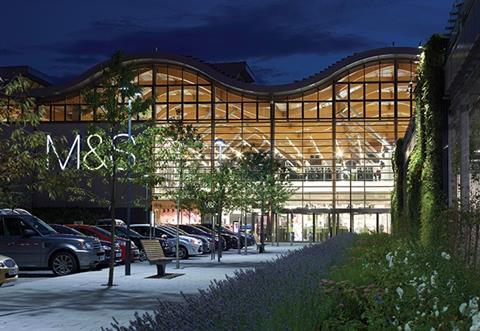These projects employed bold design features that have seen the finished articles flourish, particularly when it comes to meeting their ambitious sustainability targets


Marks and Spencer, Cheshire Oaks (Simons Group)
M&S’ Cheshire Oaks store, which opened in 2012, was set the ambitious target of beating an equivalent store (M&S White City) in a comprehensive range of areas, including using around two-thirds of the energy. A recent post-occupancy review revealed that Cheshire Oaks has smashed its targets. It has achieved a 40% reduction in energy use compared with White City, against a target of 30%, and the new store emits 40% fewer carbon emissions, against the target of 35%. The building’s insulation also means that it loses less than 1˚C of heat overnight in winter, compared with 9˚C in other stores. In addition, Cheshire Oaks’ 80,000-litre rainwater harvesting tank supplies 30% of the store’s water, against a target of 25%. The store neatly proves that the in-use phase need not let down a project’s original sustainability intentions, however ambitious - and can even better them.

City Campus East, Northumbria University (Atkins)
The two buildings of City Campus East, which house Northumbria University’s schools of law, business and design, opened in 2007. Atkins’ striking design for the buildings forms a distinctive focal point in Newcastle that has sparked regeneration of the local area. The project also achieved a BREEAM “excellent” rating for sustainability, with green features such as computerised energy and lighting systems, natural ventilation, rainwater harvesting and solar water heating - none of which were common at the time of construction. The popularity of City Campus East has been proved by demand from students resulting in the university introducing 24-hour access. In addition, Northumbria University has climbed up the Times’ student satisfaction rankings, currently sitting at 21 out of 111. Atkins concludes that the development “has exceeded the client’s expectations”.
Green Space, Chelmsford (Ingleton Wood)
Green Space, which consists of six houses and four flats in Chelmsford, was designed with the aim of being “net zero carbon” and meeting Code for Sustainable Homes Level 6, which it achieved on completion in 2010, one of the first schemes in the UK to have done so. The affordable housing scheme’s energy-reduction measures include an insulation system that achieved a U-value of 0.13 W/m2K, communal biomass boilers and photovoltaic panels. In addition, ventilation was controlled tightly, with the development targeting a low air test rate of 1.0 m3/m2/hr @ 50Pa, thereby greatly reducing heat lost. With the development now having been lived in for four years, a post-occupancy study concluded that the homes maintain a steady, comfortable environment with the need for only a minimal injection of energy. The study revealed that compared with predicted energy use for space heating, the scheme outperformed expectations by between 47% and 72%.

This award was sponsored by May Design Series.




























No comments yet